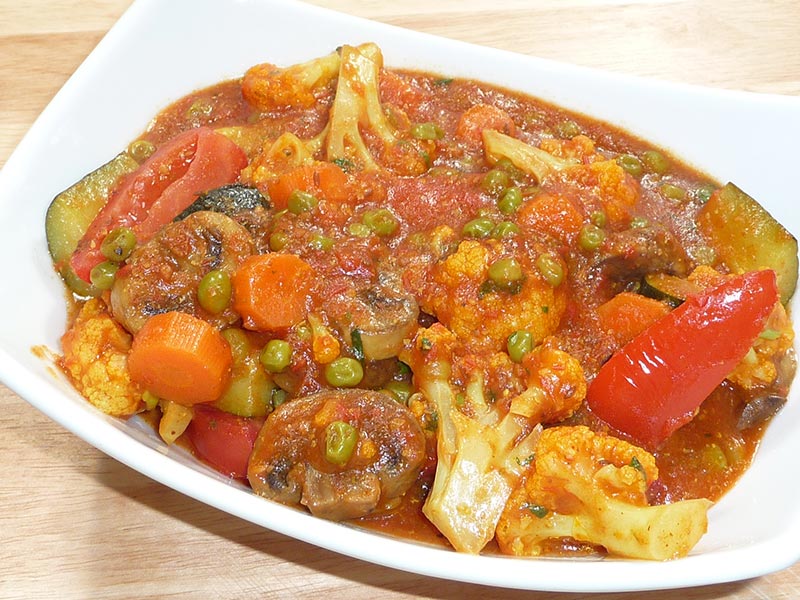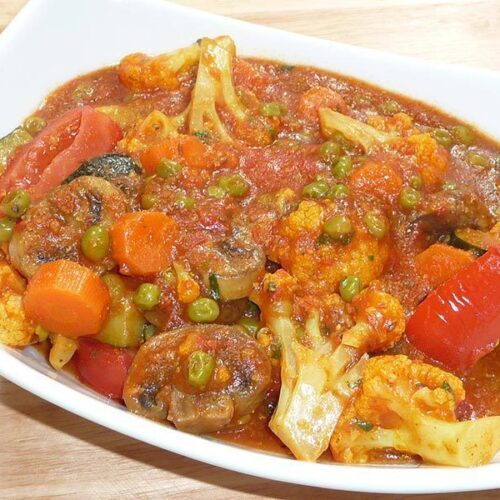Vegetable Curry
Ingredients
- 2 cups Approx. cauliflower cut into florets phool gobhi
- 1 cup green peas hari matar
- 1 carrot diced in about 1/2 inch pieces gajar
- 1/2 cup sliced mushrooms
- 1 medium zucchini cut into bite size pieces with skin
- 6 tomatoes medium size
- 1/2 inch ginger
- 1 green chili
- 2 tbsp oil
- 1/2 tsp cumin seeds jeera
- 1/8 tsp asafetida hing
- 1/4 tsp turmeric haldi
- 1/4 tsp red chili powder
- 1 tbsp coriander powder dhania
- 1 tsp salt
- 1 tsp sugar
- 1 tbsp corn starch
- 1/2 tsp garam masala
- 2 tbsp cilantro finely chopped hara dhania
Instructions
- Mix the cornstarch with ¼ cup of water and set aside.
- Blend 5 sliced tomatoes, green chilies and ginger to make a puree. If you prefer mild take the seeds out of green chili before blending.
- Slice 1 tomato length wise into 8-10 pieces and set aside.
- Heat the oil in a saucepan. Test the heat by adding one cumin seed to the oil. If the cumin seed cracks right away, the oil is ready. Add the cumin seeds, and asafetida, as the seeds crack add tomato puree, coriander, turmeric, sugar, and salt. Cover the pot and cook for about 5 minutes.
- Add all the vegetables and ¼ cup of water. Cover the pan and let it cook for about 10 minutes over medium heat stir a few times in between. Vegetables should be tender not mushy.
- Add cornstarch mixture and let it cook for 2 more minutes. Cornstarch is added to thicken the gravy. If gravy is too thick add some hot water as needed.
- Turn off the heat, add tomato slices, garam masala and cilantro, stir and cover the pan for few minutes before serving.
Notes
Vegetable Curry: A Flavorful and Nourishing Dish
Vegetable curry is a vibrant Gluten Free and aromatic dish that’s beloved in cuisines around the world, particularly in South Asia and Southeast Asia.
This versatile vegan dish features a variety of vegetables cooked in a rich and fragrant sauce made from spices, herbs, and can be cooked with coconut milk or yogurt.
Vegetable curry is incredibly nourishing, packed with vitamins, minerals, and fibre from the assortment of vegetables used.
Benefits of Vegetable Curry:
Nutrient-Rich: Vegetable curry is packed with essential nutrients from a wide range of vegetables, including vitamins, minerals, and antioxidants. Eating a diet rich in vegetables has been linked to numerous health benefits, including reduced risk of chronic diseases such as heart disease, diabetes, and certain cancers.
Fibre-Packed: Vegetables are naturally high in fibre, which is essential for digestive health, weight management, and blood sugar control. Fibre that helps promote satiety and keeps you feeling full for longer periods, making vegetable curry a satisfying and filling meal option.
Customizable: Vegetable curry is highly customizable, allowing you to use vegetables you have on hand or prefer. From hearty root vegetables like potatoes and carrots to leafy greens like spinach and kale, the possibilities are endless for creating your own unique version of vegetable curry.
Flavorful and Comforting: Vegetable curry is bursting with bold and complex flavours from the spices and herbs used in the sauce. The aromatic blend of spices such as cumin, coriander, turmeric, and garam masala creates a warm and comforting dish that’s perfect for cosy nights in or sharing with loved ones.
Variations of Vegetable Curry:
Potato in Coconut Gravy: This is a beautiful looking dish! Mouthwatering, heat from red chilies and sweet and sourness from tamarind make this dish exotic. This is a great dish for me and our family when we want a change from our regular tomato or yoghurt based gravy.
Kela Ki Subji (Banana Curry): This is a delicious sweet and sour dish, and only takes few minutes to prepare. Kela Ki Sabji makes a great side dish. You will be amazed with the simplicity of this dish.
Sweet & Sour Tofu: Tofu and vegetables cooked with the tamarind sauce makes a very unique flavorful dish. This Sweet and Sour Tofu dish is vegan-friendly and It is enjoyable for just about anybody’s taste palette.
Aloo Matar: This is a popular north Indian dish. Potatoes and peas with spicy gravy makes a great main dish.
FAQs about Vegetable Curry:
Can I make vegetable curry ahead of time?
Yes, vegetable curry can be made ahead of time and stored in the refrigerator for up to 3-4 days. Reheat the curry gently on the stovetop or in the microwave before serving, adding a splash of water or coconut milk if needed to adjust the consistency.
Is vegetable curry gluten-free?
Yes, vegetable curry is naturally gluten-free as long as the ingredients used are free from gluten-containing additives or cross-contamination. Be sure to check the labels of packaged spices and sauces to confirm their gluten-free status.
Can I make vegetable curry vegan-friendly?
Absolutely! Vegetable curry is naturally vegan-friendly as it does not contain any animal products. Ensure that the ingredients used, such as curry paste, coconut milk, and yogurt substitutes, are also vegan-friendly.
What can I serve with vegetable curry?
Vegetable curry pairs well with a variety of accompaniments, including rice, naan bread, roti, or quinoa. Garnish the curry with fresh herbs such as cilantro or mint and serve with a side of yogurt or chutney for added flavor. Vegetable curry is a flavorful and nourishing dish that’s perfect for satisfying hunger and nourishing the body. With its versatility, health benefits, and endless variations, vegetable curry is a staple in many cuisines around the world. Whether enjoyed as a main course or a side dish, vegetable curry is sure to delight your taste buds and leave feeling satisfied and nourished.



Leave a Reply
You must be logged in to post a comment.